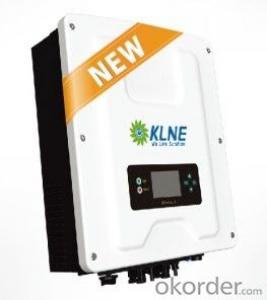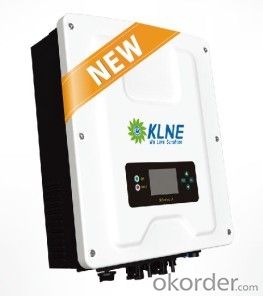6000W Solartec D 3000 Solar On Grid Inverter with 2 MPPT WiFi
- Loading Port:
- Shanghai
- Payment Terms:
- TT OR LC
- Min Order Qty:
- -
- Supply Capability:
- 10000 set/month
OKorder Service Pledge
Quality Product, Order Online Tracking, Timely Delivery
OKorder Financial Service
Credit Rating, Credit Services, Credit Purchasing
You Might Also Like
Solartec D 2500,3000,3600,4000,4600,5000
2MPPT Trackers
online monitoring system by integrated WIFI
Integrated DC Switch
Comprehensive protection functions
Graphic display
High efficiency 97.5%
RS 485/RS 232/SolarLog Communication
5 Years warranty
G83,G59,VDE 4105,VDE 0126,CEI
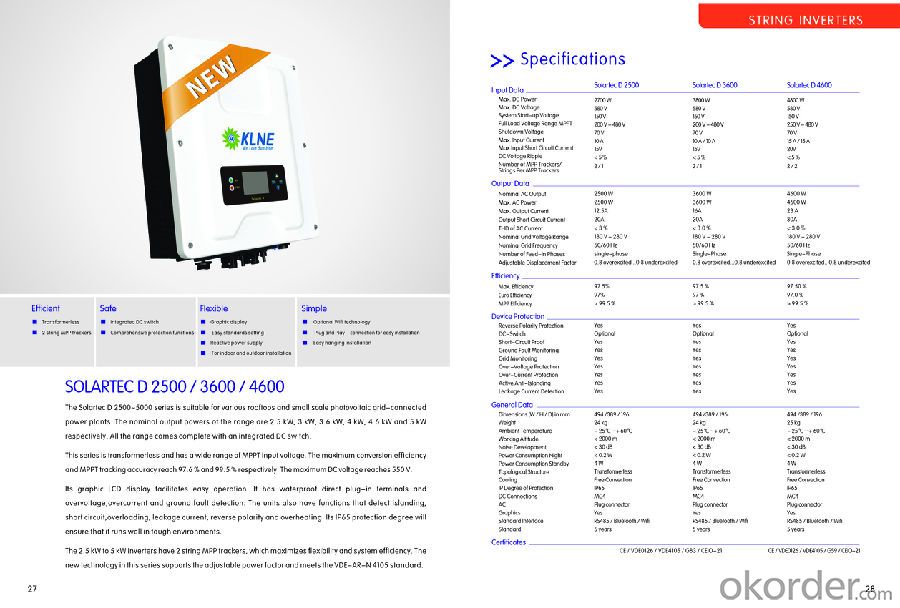
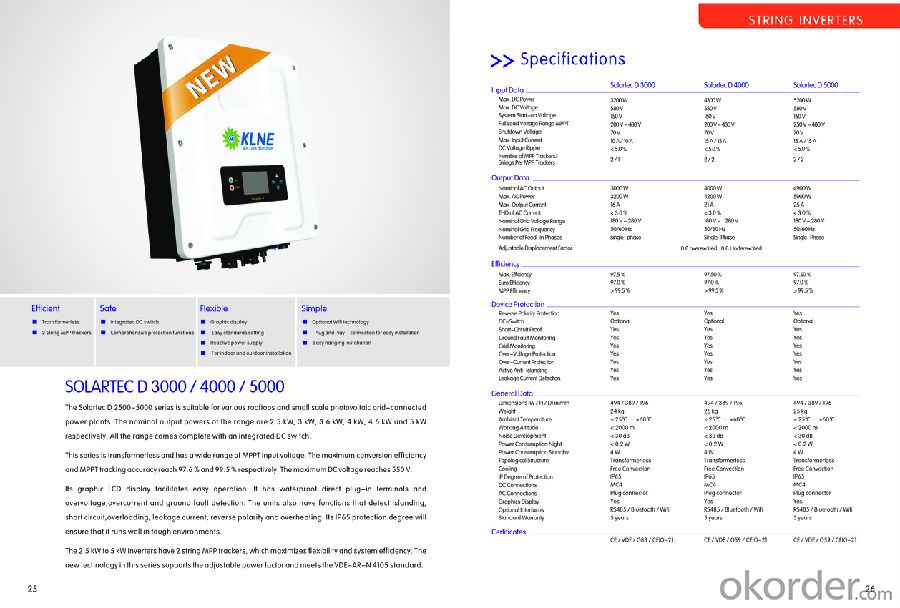
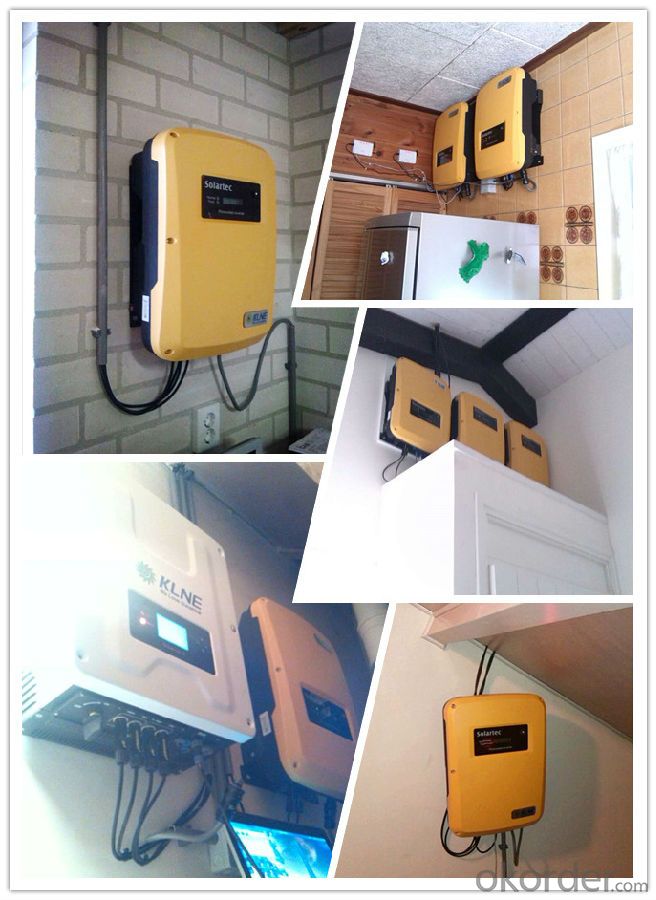
- Q: How does a solar inverter handle grid faults or disturbances?
- A solar inverter handles grid faults or disturbances by continuously monitoring the grid voltage and frequency. When a fault or disturbance is detected, the solar inverter quickly disconnects from the grid to ensure safety and protect the system. It then enters a standby mode until the grid returns to normal conditions. Once the grid stabilizes, the solar inverter reconnects and resumes its normal operation of converting solar energy into usable electricity.
- Q: Can a solar inverter be used with different types of solar cell technologies?
- Yes, a solar inverter can be used with different types of solar cell technologies. Solar inverters are designed to convert the DC electricity generated by solar panels, regardless of the type of solar cell technology, into AC electricity that can be used to power homes and businesses. Therefore, whether it is monocrystalline, polycrystalline, thin-film, or any other solar cell technology, a solar inverter can efficiently convert the generated electricity into usable form.
- Q: Can a solar inverter be used in a solar-powered desalination system?
- Yes, a solar inverter can be used in a solar-powered desalination system. A solar inverter is responsible for converting the direct current (DC) electricity produced by solar panels into alternating current (AC) electricity, which is required to power the desalination system. By utilizing a solar inverter, the solar energy generated can be efficiently utilized to operate the desalination process, making it a sustainable and environmentally friendly solution for producing fresh water from seawater.
- Q: How does a solar inverter convert DC to AC?
- A solar inverter converts direct current (DC) into alternating current (AC) by utilizing a two-step process. First, it converts the DC electricity generated by solar panels into a high-frequency AC waveform. This is done by using electronic components, such as transistors or power semiconductors, to switch the DC input on and off rapidly. Next, the high-frequency AC waveform is transformed into a stable and synchronized AC output that is suitable for use in home or commercial electrical systems. This is achieved through the use of filters, transformers, and other circuitry that adjust the voltage, frequency, and waveform of the AC output to match the requirements of the utility grid or the electrical load being powered. Overall, the solar inverter's key function is to efficiently convert the DC electricity produced by solar panels into a usable form of AC electricity that can be used to power appliances, machinery, and other electrical devices.
- Q: How does a solar inverter handle fluctuations in solar panel output?
- A solar inverter handles fluctuations in solar panel output by constantly monitoring the incoming DC power from the panels and adjusting its own output to match the required AC power demand. It utilizes Maximum Power Point Tracking (MPPT) technology to optimize the energy conversion process, ensuring that the inverter extracts the maximum power from the solar panels even if the output fluctuates due to factors like shading or varying sunlight intensity. This allows for a stable and reliable power supply to the electrical grid or connected devices.
- Q: Can a solar inverter be used with a solar-powered water purification system?
- Yes, a solar inverter can be used with a solar-powered water purification system. A solar inverter is responsible for converting the direct current (DC) electricity produced by solar panels into alternating current (AC) electricity that can be used to power various appliances and systems. In the case of a solar-powered water purification system, the solar inverter would be essential in converting the DC electricity generated by the solar panels into the appropriate AC power required to operate the system's pumps, filters, and other components.
- Q: How does a solar inverter handle voltage unbalance?
- A solar inverter handles voltage unbalance by continuously monitoring the voltage levels of the three phases in the grid. If it detects any imbalance, it adjusts the output voltage accordingly to maintain balance and ensure optimal performance.
- Q: How does the power factor correction affect the performance of a solar inverter?
- Power factor correction can greatly improve the performance of a solar inverter by ensuring that the power drawn from the grid is utilized efficiently. By correcting the power factor, the inverter reduces the reactive power component and increases the power factor closer to unity. This reduction in reactive power results in a more efficient utilization of the available power, leading to increased energy conversion efficiency and reduced losses in the inverter. Additionally, power factor correction helps in complying with grid regulations and prevents penalties or restrictions imposed by utility companies.
- Q: How does a solar inverter handle voltage flicker?
- A solar inverter handles voltage flicker by continuously monitoring the voltage fluctuations in the grid and adjusting its output accordingly. It uses advanced control algorithms to stabilize the voltage and maintain a consistent power supply to the connected devices. Additionally, it may have built-in features such as reactive power compensation and voltage regulation to minimize voltage flicker and ensure a smooth and reliable energy conversion process.
- Q: Can a solar inverter be used with different types of grounding materials?
- Yes, a solar inverter can be used with different types of grounding materials. However, it is important to ensure that the grounding system is compatible with the specific requirements and guidelines provided by the manufacturer of the solar inverter. The grounding materials used should meet the necessary safety standards and provide proper electrical grounding for the solar installation. It is recommended to consult with a qualified electrician or solar professional to determine the appropriate grounding materials for your specific solar inverter and installation.
Send your message to us
6000W Solartec D 3000 Solar On Grid Inverter with 2 MPPT WiFi
- Loading Port:
- Shanghai
- Payment Terms:
- TT OR LC
- Min Order Qty:
- -
- Supply Capability:
- 10000 set/month
OKorder Service Pledge
Quality Product, Order Online Tracking, Timely Delivery
OKorder Financial Service
Credit Rating, Credit Services, Credit Purchasing
Similar products
Hot products
Hot Searches
Related keywords
